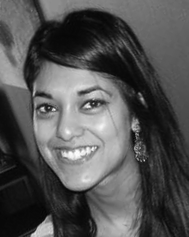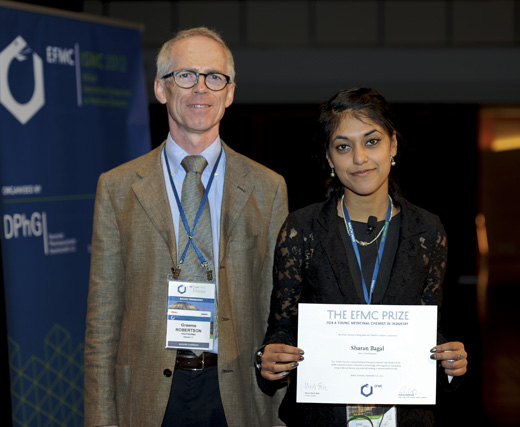 .
.Sharan Bagal CChem MRSC
Medicinal Chemistry Team leader - Worldwide Medicinal Chemistry, Senior Principal Scientist at Pfizer Neusentis
https://uk.linkedin.com/in/sharan-bagal-cchem-mrsc-81729919
https://www.facebook.com/sharan.bagal
Summary
Summary:
10 years pharmaceutical industry experience, hardworking, highly
motivated individual with demonstrable impact and candidate delivery
Key highlights
- Direct inventorship role in the identification of 5 clinical candidates, 3 of which are in Phase I/II
- 33 publications including 13 published patents
- 2012 European Federation for Medicinal Chemistry Prize winner “Young Medicinal Chemist in Industry”
- Granted 7 department impact awards and numerous additional awards for effective problem solving
- Project Managed cross-functional teams within a project to ensure timely delivery of key milestones
- Excellent team member used to working in a multi-disciplinary environment
- Strong organisational and negotiation skills both in an internal and external environment
- Experience with ligand- and structure-based drug design
- Excellent scientific writing skills, oral communication skills, and data visualisation and analysis ability
- Direct line management of up to 4 chemistry graduates per year and 1 Ph.D student
- Internationally recognised subject matter expert through organisation of collaborations with academics, working on RSC, GRC and EFMC committees, referee work, internalisation of external technology, and tutoring at Oxford
- Ability to identify and apply novel methodology to current drug discovery problems through successfully securing departmental funding based on written proposals of work that are accepted by the leadership team
Specialities: medicinal chemist,
clinical candidate, research associate, drug discovery, chemist,
research, scientist, project manager, preclinical protocol and dossier
writing, regulatory affairs, CMC, Good Clinical Practice, GCPKey highlights
- Direct inventorship role in the identification of 5 clinical candidates, 3 of which are in Phase I/II
- 33 publications including 13 published patents
- 2012 European Federation for Medicinal Chemistry Prize winner “Young Medicinal Chemist in Industry”
- Granted 7 department impact awards and numerous additional awards for effective problem solving
- Project Managed cross-functional teams within a project to ensure timely delivery of key milestones
- Excellent team member used to working in a multi-disciplinary environment
- Strong organisational and negotiation skills both in an internal and external environment
- Experience with ligand- and structure-based drug design
- Excellent scientific writing skills, oral communication skills, and data visualisation and analysis ability
- Direct line management of up to 4 chemistry graduates per year and 1 Ph.D student
- Internationally recognised subject matter expert through organisation of collaborations with academics, working on RSC, GRC and EFMC committees, referee work, internalisation of external technology, and tutoring at Oxford
- Ability to identify and apply novel methodology to current drug discovery problems through successfully securing departmental funding based on written proposals of work that are accepted by the leadership team
Experience
Senior Principal Scientist Medicinal Chemistry Team Leader
Pfizer Neusentis
I
am 1 of 8 medicinal chemists chosen from Pfizer Sandwich Chemistry
(~150 chemists) to set up the Pain Chemistry unit in Cambridge UK after
Pfizer Sandwich chemistry closure. I worked on 5 different projects (ion
channel, kinase) that were ligand- and structure-based, in the
exploratory and candidate seeking arena being accountable for timely
project delivery. This role involved organisation and management of
cross-functional teams together with leading the chemistry strategy. I
regularly presented to the leadership team in order to secure funding
for research activities to enable project progression. Our team
delivered 2 clinical candidates and numerous hit-to-lead series to
underwrite 2 Lead Development transitions. On several occasions I
managed cross site drug discovery project teams – US/UK, India/UK,
Europe/UK.
- (Open)1 honor or award
Principal Scientist Medicinal Chemistry Team Leader
Pfizer
I
worked on 3 different projects (ion channel, kinase, GPCR) that were
ligand- and structure-based, in the exploratory and candidate seeking
arena, across 2 therapeutic areas (Pain and Allergy/Respiratory).
Moreover our team designed, synthesised and advanced 3 compounds for
clinical development that are currently in Phase I/II.
Postdoctoral Research in Synthetic Chemistry
Professor Samir Z. Zard
In
collaboration with Professor S. Z. Zard, I have developed a novel acyl
radical equivalent. Furthermore, I have devised a facile method for the
generation of radicals from aldehydes.
- (Open)1 honor or award
Graduate Research Assistant
National Physical Laboratory
In
collaboration with Dr. B. Nimmo, research was conducted into the
calibration of a scanning vibrating electrochemical probe. I designed
novel experiments followed by publication of a detailed report.
Honors & Awards
EFMC Prize for Young Medicinal Chemist in Industry
European Federation for Medicinal Chemistry (EFMC)
EFMC Prize for Young Medicinal Chemist in Industry
“The
EFMC Prize for Young Medicinal Chemist in Industry” was initiated to
acknowledge and recognize an outstanding young medicinal chemist (≤ 35
years old) working in industry within Europe. The Prize is given
annually and consists of a diploma, € 1.000 and an invitation for a
short presentation at an EFMC symposium. .Egide scholarship to fund postdoctoral studies
Egide
Syngenta Postgraduate Scholarship in Organic Chemistry
Syngenta
Scholarship to fund postgraduate studies.
University Graduate Studentship Scheme (UGGS)
Glaxo Wellcome Prize
Glaxo Wellcome
Glaxo Wellcome Prize is presented based upon experimental work and written submission
Oxford University Scholarship for academic excellence
Oxford University
Oxford
University Scholarship for academic excellence is awarded when a 1st
year student passes Prelim examinations with Distinction honours, and
thus becomes a Scholar
Patents
Preparation of N-acylpiperidine ethers as kinase inhibitors
United States WO2015092610
Filed 2015Tropomyosin-related kinase inhibitors
United States WO2015170218
Filed 2015Tropomyosin-related kinase inhibitors
United States WO2015159175
Issued 2015Kinase Inhibitors
United States WO 2014053968
Issued 2014Kinase Inhibitors
United States WO 2014053967
Filed 2014Kinase Inhibitors
United States WO 2014053965
FiledChemical Compounds
United States WO 2013061205
Issued 2013Benzimidazole Derivatives
United States WO 2013114250
Issued 2013Bagal, S. K.; Skerratt, S. et al. “Kinase Inhibitors” PCT Int. Appl. 2012
United States WO 2012137089
Filed 2012Cyclobutenedione Derivatives
United States WO 2010131147
Filed 2010- 2 inventors:
Cyclobutenedione Derivatives
United States WO 2010131146
Filed 2010Cyclobutenedione Derivatives
United States WO 2010131145
Issued 2010Pyridine Derivatives
United States WO 2008135826
Issued 2008Publications
Concise and highly selective asymmetric synthesis of acosamine from sorbic acid
Bagal, S. K.; Davies, S.; Scott, P. M. “Concise and Highly Selective Asymmetric Synthesis of Acosamine from Sorbic Acid”, Tetrahedron Letters, 2010, 52, 2216
Syntheses of the Enantiomers of 1-Deoxynojirimycin and 1-Deoxyaltronojirimycin via Chemo- and Diastereoselective Olefinic Oxidation of Unsaturated Amines
Bagal, S. K.; Davies, S.; Scott, P. M. “Syntheses of the Enantiomers of 1-Deoxynojirimycin and 1-Deoxyaltronojirimycin via Chemo- and Diastereoselective Olefinic Oxidation of Unsaturated Amines”, Journal of Organic Chemistry, 2010, 75, 8133
An Efficient Oxidation & Ring-Contraction Approach to Synthesis of Racemic 1-Deoxynojirimycin & 1-Deoxyaltronojirimycin
Bagal, S. K.; Davies, S.; Scott, P. M. “An Efficient Oxidation and Ring-Contraction Approach to Synthesis of Racemic 1-Deoxynojirimycin and 1-Deoxyaltronojirimycin”, Organic Letters, 2009, 12, 136
Recent advances in biomimetic natural product synthesis
Bulger, P. G.; Bagal, S. K.; Marquez R. “Recent Advances in Biomimetic Natural Product Synthesis”, Natural Products Reports, 2008, 25, 254
Radicals from Aldehydes. A Convergent Access to Dienes and d-Lactones
Bagal, S. K.; Tournier, L.; Zard, S. Z. “Radicals from Aldehydes. A Convergent Access to Dienes and d-Lactones”, Synlett, 2006, 10, 1485
Cyano(ethoxycarbonothioylthio)methyl benzoate: A Novel One-Carbon Radical Equivalent
Bagal, S. K.; de Greef, M.; Zard, S. Z. “Cyano(ethoxycarbonothioylthio)methyl benzoate: A Novel One-Carbon Radical Equivalent”, Organic Letters, 2006, 8, 147
Regioselectivity of Dimerisation of Butenolides via Captodative Stabilised Radicaloid Intermediates
Bagal, S. K.; Adlington R. M.; Brown, R. A. B.; Baldwin, J. E. Tetrahedron Letters, 2005, 46, 4633
Dimerization of Butenolide Structures. A Biomimetic Approach to the Dimeric Sesquiterpene Lactones (±)-Biatractylolide and (±)-Biepiasterolide
Bagal, S. K.; Baldwin, J. E.; Adlington R. M.; Marquez R. Journal of Organic Chemistry, 2004, 69, 9100
Biomimetic Synthesis of Biatractylolide and Biepiasterolide
Bagal, S. K.; Baldwin, J. E.; Adlington R. M.; Marquez R. Organic Letters, 2003, 5, 3049
Studies towards the Biomimetic Synthesis of Bisesquiterpenoid Lactones
Bagal, S. K.; Baldwin, J. E.; Adlington R. M.; Marquez, R. Tetrahedron Letters, 2003, 44, 4993
Full efficacy with no CNS side-effects: unachievable panacea or reality? - DMPK considerations in design of drugs with limited brain penetration
Bagal, S. K.; Cole, S. et al. “Full efficacy with no CNS side-effects: unachievable panacea or reality? - DMPK considerations in design of drugs with limited brain penetration” Xenobiotica, 2011, 1
1. Optimising drug properties can be an important strategy to limit penetration into the CNS and offers advantages
in reducing the risk of undesirable neurological effects
2. When considering the design of these drugs it is important to consider the relative influx and efflux rates at the
relevant biological membranes
3. The highest degree of restriction at the brain is probably achievable by...more
in reducing the risk of undesirable neurological effects
2. When considering the design of these drugs it is important to consider the relative influx and efflux rates at the
relevant biological membranes
3. The highest degree of restriction at the brain is probably achievable by...more
Successful medicinal chemistry strategies in the TLR7 agonist programme to avoid aldehyde oxidase metabolism
Bagal, S. K.; Pryde, D. et al. “Successful medicinal chemistry strategies in the TLR7 agonist programme to avoid aldehyde oxidase metabolism” Bioorganic and Medicinal Chemistry Letters, 2012, 2856
Voltage Gated Sodium channels as Drug Discovery Targets
Bagal, S. K.; Pryde, D. et al. “Successful medicinal chemistry strategies in the TLR7 agonist programme to avoid aldehyde oxidase metabolism” Bioorganic and Medicinal Chemistry Letters, 2012, 2856
Discovery and optimization of selective Nav1.8 modulator series that demonstrate efficacy in preclinical models of pain
Bagal S. K. et al. “ Discovery and optimization of selective Nav1.8 modulator series that demonstrate efficacy in preclinical models of pain”, ACS Medicinal Chemistry Letters 2015, 650
Recent progress in sodium channel modulators for pain
Bagal S. K. et al. “Recent progress in sodium channel modulators for pain”, Bioorganic & Medicinal Chemistry Letters 2014, 3690
Designing peripheral drugs for minimal brain exposure, book chapter
Bagal S. K. et al. “Designing peripheral drugs for minimal brain exposure”, book chapter in Blood-Brain Barrier in Drug Discovery: Optimizing Brain Exposure of CNS Drugs and Minimizing Brain Side Effects”, Wiley, 2014, Chapter 20, 446
PF-1247324, a structurally novel selective Nav1.8 blocker that reduces excitability in human sensory neurons in vitro and attenuates nociception in models of inflammatory and neuropathic pain
Bagal, S. K.; Payne, L. et al. British Journal of Pharmacology, 2015, 2654
Restricting CNS penetration of drugs to minimize adverse events: role of drug transporters
Bagal S. K. ; Bungay, P. ; “Restricting CNS penetration of drugs to minimize adverse events: role of drug transporters”, Drug Discovery Today Technology, 2014, 79
Ion Channels as Therapeutic Targets: A Drug Discovery Perspective
Bagal, S. K.; Pyrde, D. et al. “Ion Channels as Therapeutic Targets: A Drug Discovery Perspective”, Journal of Medicinal Chemistry. 2013, 593
Minimising drug exposure in the CNS whilst maintaining good oral absorption
Bagal S. K. ; Bungay, P. “Minimising drug exposure in the CNS whilst maintaining good oral absorption”, ACS Medicinal Chemistry Letters, 2012, 948
Education
University of Oxford
MChem ( Masters + B.Sc), Chemistry
First Class Honours (within top 10 of year / Top 3%)
- (Open)2 honors and awards
Cornerstones of Management, Pfizer
People Management, Pass
Highly
interactive and intensive program developed to build managerial
capability and capacity across the global organization. It is comprised
of three face-to-face workshop experiences geared to develop key manager
accountabilities that align with your role as a manager:
Delivering Results - Expectations of a Pfizer Manager Engaging Talent - Leading People, Teams and Projects Successfully
Shaping the Future - Coaching & Developing for Peak Performance
Organizations
RSC Biorganic and Medicinal Chemistry Section
RSC Bio-Org and Med Chem Section Committee Member: Organise RSC conferences/UK education
Starting
Transporters conference organiser 2014
Anglo Nordic Medicinal Chemistry Conference Chair organiser
Anglo Nordic Medicinal Chemistry Conference Chair organiser


Dr. Sharan K. Bagal (1978) graduated with first class honours in MChem in 2001 from the University of Oxford, U.K. where she subsequently completed her DPhil in chemistry in 2004 under the supervision of Professor Sir Jack Baldwin and Dr. Robert Adlington. Her doctorate was based on biomimetic natural product synthesis, in particular, the first total synthesis of two natural products biatractylolide and biepiasterolide via a biomimetic radical dimerisation. Sharan then moved to Professor Samir Zard’s group at the École Polytechnique in France as a postdoctoral researcher studying xanthate-based radical chemistry. This work led to the development of a novel acyl radical equivalent, along with a facile method for the generation of radicals from aldehydes.
In 2006 Sharan joined Pfizer Global Research and Development, Sandwich, UK as a medicinal chemist (www.pfizer.com), and is now a Senior Principal Medicinal Chemist at Pfizer Neusentis in Cambridge, UK (www.neusentis.com) with a focus on drug discovery targets for the treatment of pain. Sharan’s research interests encompass all aspects of medicinal chemistry and she has worked on several drug discovery targets including voltage-gated ion channels, GPCRs and protein kinases e.g. NaV1.8 and CXCR1/2. This work has used ligand-based medicinal chemistry design methods to identify potent and selective ion channel modulators within highly challenging medicinal chemistry space, and highly potent chemokine receptor antagonists with a balanced subtype selectivity profile. More recently, Sharan has used structure-based design methodology to successfully design highly potent receptor tyrosine kinase inhibitors with excellent selectivity and a favourable tissue distribution profile. Her focus has ranged from hit identification, hit to lead optimisation and candidate selection and Sharan has been directly involved in the invention of two compounds currently undergoing clinical trials.
So far over her career, Sharan has co-authored more than 20 papers and patents. She has a particular interest in aldehyde oxidase (AO) catalysed metabolism, in particular the structural aspects that underpin substrate recognition by AO and the role played by both steric and electronic effects of susceptible ring systems. She has developed several datasets that inform how structural features relate to species-specific metabolism by AO, and hypotheses of how this metabolism can be switched off by design. Sharan has also developed an interest in the design of compounds that penetrate, or are restricted from, the central nervous system (CNS) based on an understanding of CNS-located transporters and compound physicochemistry and the implications of CNS distribution on drug safety. She has delivered several reviews and presentations in this area.
The insider: Mixing synthesis and drug discovery
http://www.rsc.org/chemistryworld/Issues/2009/January/MixingSynthesisAndDrugDiscovery.aspSarah Houlton talks to Sharan Bagal about life as a medicinal chemist

Sharan Bagal, Pfizer
|
If
you're considering a career in medicinal chemistry, then talking to
Sharan Bagal at pharma giant Pfizer might be just the boost you need.
Bagal decided she wanted to be a medicinal chemist during her PhD with
Jack Baldwin at Oxford. 'I was keen to find a career that challenged me
scientifically and which used my training in organic synthesis,' she
says. And after gaining a further year's experience as a postdoc with
Samir Zard in France, she accepted a job as a trainee medicinal chemist
at Pfizer. She's now been based in their labs in Sandwich, Kent for
two-and-a-half years.
'My job is a great mix of
synthesis and drug discovery,' she says. 'As a trainee designer, you
start off doing a lot of synthesis while your knowledge of medicinal
chemistry grows. Learning the subject is fascinating - there are so many
new concepts to grasp. While the fundamentals can be learnt from a text
book, you can only really learn how to be a medicinal chemist by
actually doing the job, getting a 'feel' for designing compounds that
have the biological activity we want, and which don't have other
biological activities that can cause side-effects. You can only learn
this sort of thing from working with and hearing about real-life
examples.'
Bagal also loves the fact that she works
as part of a team - it's very different from a PhD or postdoc project.
'We're all working on the same project, so there's always other people
to talk things through with,' she says. 'The team consists of both
medicinal chemists and synthetic chemists. And I don't just work with
other chemists - I get to interact with scientists from other
disciplines, such as biologists who find out whether the compounds I've
designed really are active, and drug metabolism experts who work out
whether they are likely to be stable in the body. I've learnt so much
just by seeing the results of their experiments and how they match up to
our predictions.'
A typical day for Bagal starts
with checking whether any new data on the compounds the team has made
has arrived. These results determine what next steps will be made in the
drug design process - either because the activity they were hoping for
is there, or because it isn't. She also checks the literature - alerts
arrive in her inbox every night - to help keep on top of the field. And
then it's down to the business of designing the next potential lead
compound - and getting on with synthesising it.
Stick with the team
'I
think it's important to carry on with synthesis while you're training
as a medicinal chemist,' she says. 'Otherwise, there's a danger of
removing yourself from the rest of the team who work in synthesis while
you're learning - and it's important that we all work together. As you
gain more experience, the amount of medicinal chemistry you do
increases, while the synthesis side decreases. My boss, the team's
design lead, is an experienced medicinal chemist who concentrates solely
on medicinal chemistry, and there's another trainee medicinal chemist
in the team who started a year after I did so is still doing more
synthesis than I do.'

While
the job market in the pharmaceutical industry is uncertain at the
moment and (as with so many other sectors) no one can rely on having a
career within a single company for life, Bagal has no regrets about her
choice as it offers her great opportunities for learning and promotion.
Bagal supervises a graduate chemist in her team, and mentors a chemist
from another team. 'With my supervisee, the focus is very much on
practical and technical chemistry skills, whereas it's more going
through research papers and problem solving with the graduate I mentor,'
she says. 'It's also really useful for me as it makes sure I keep up
with what's going on in the literature!'
And she
believes there will always be opportunities for good scientists. 'The
great thing about medicinal chemistry is that you're faced with problems
and you've got a variety of tools to help you solve them,' she says.
'You develop a hypothesis, and synthetic chemistry helps you prove or
disprove it. I have so much freedom to try out my ideas and see if they
work - and it's very rewarding when they do.
I am learning a whole new science.'
I am learning a whole new science.'

Neusentis
Research Institute
Address: The Portway Building, Granta Park, Great Abington, Cambridge CB21 6GS, United Kingdom
Ruth McKernan, chief scientific officer for Neusentis Ltd., a unit of Pfizer Inc., speaks during an interview at the company's research centre in Cambridge, ...

////



No comments:
Post a Comment